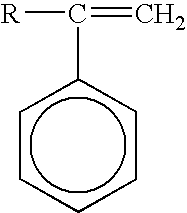Superabsorbent polymers and method of manufacturing the same
- Summary
- Abstract
- Description
- Claims
- Application Information
AI Technical Summary
Benefits of technology
Problems solved by technology
Method used
Image
Examples
example 1
[0071] In general, PAA can be prepared from an aqueous solution containing about 10% to about 40%, preferably about 15% to about 35%, more preferably about 20% to about 30%, and most preferably about 25% to about 28% by weight, by weight, acrylic acid, with an appropriate amount of internal crosslinking monomer. A PAA so obtained, after admixture with a clay, is neutralized with sodium carbonate, potassium carbonate, ammonium carbonate, sodium hydroxide, or a mixture thereof, to DN=60-95.
[0072] In particular, a solution containing 25% by weight acrylic acid, 0.07 mole percent methylenebisacrylamide, appropriate levels of initiators (2,2-azobis(2-amidinopropane)dihydrochloride and sodium persulfate), at an initiator temperature of 18° C., yielded a PAA which, when neutralized with sodium carbonate powder to DN=75 percent and then dried, milled, sized, and post-modified by surface crosslinking, yielded a PAA with an average gel volume of 41.2 gm / gm, an absorption under load (AUL) of ...
example 2
[0078] To a suitable reactor was added 800 parts of acrylic acid, 4 parts of tetraallyloxyethane, 1818.2 parts of 2.2 percent oxidized starch in water, and 1347.8 parts of water. Nitrogen was bubbled through the resulting solution, and the temperature was lowered to 100° C. When the dissolved oxygen was reduced below 1 ppm, the following catalysts were added in the listed order: 2.4 parts of 2,2-azobisamidinopropane dihydrochloride in 10 parts of water; 0.2 parts of ascorbic acid in 10 parts of water; 2.29 parts of 35 percent hydrogen peroxide in 10 parts of water.
[0079] After a short induction period, polymerization began and a peak temperature of 65-70° C. was reached in two hours. The PAA gel was retained in an insulated container for three hours to reduce residual monomer below 1000 ppm.
[0080] Clay Component
[0081] A clay useful in the present SAP-clay particles can be a swelling or a nonswelling clay. Swelling clays have the ability to absorb water and are swellable, layered ...
example 3
[0100] Acrylic acid (292 grams) and pentaerythritol triallyl ether (0.800 grams) are admixed. Then, deionized water (783 grams) is added to the mixture, and stirring is continued. The resulting solution is cooled to about 10° C., then 2-hydroxy-2-methyl-1-phenylpropane (DAROCUR® 1173) (0.200 grams) and sodium persulfate (5.99 grams) are added with stirring. The resulting solution is poured into a 4 inch×8 inch glass dish and polymerized for 12.5 minutes under UV light (UV intensity=20 mW / cm2). The resulting gel is extruded through a KitchenAid meat grinder, then 5-50% ULTRAG-LOSS® 90 clay (wt % based on acrylic acid (boaa)) is added to the hydrogel, followed by two extrusions. Next, 159.15 grams of sodium carbonate is added to the clay-containing hydrogel, then the clay-containing hydrogel is extruded to neutralize the PAA. The resulting neutralized SAP-clay hydrogel is dried at 150° C. for one hour, then milled and sized to 180-710 μm. The dry SAP particles containing the clay then...
PUM
| Property | Measurement | Unit |
|---|---|---|
| Fraction | aaaaa | aaaaa |
| Fraction | aaaaa | aaaaa |
| Fraction | aaaaa | aaaaa |
Abstract
Description
Claims
Application Information
 Login to View More
Login to View More - R&D
- Intellectual Property
- Life Sciences
- Materials
- Tech Scout
- Unparalleled Data Quality
- Higher Quality Content
- 60% Fewer Hallucinations
Browse by: Latest US Patents, China's latest patents, Technical Efficacy Thesaurus, Application Domain, Technology Topic, Popular Technical Reports.
© 2025 PatSnap. All rights reserved.Legal|Privacy policy|Modern Slavery Act Transparency Statement|Sitemap|About US| Contact US: help@patsnap.com



